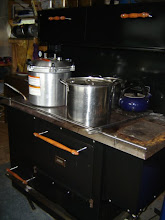I love sourdough bread, but I've been hesitant to start up a sourdough starter, without a fridge or freezer to slow the fermenting starter, I'd have to feed it regularly, which would mean either throwing starter out (since we are sans-chickens lately) or baking like a fiend. And knowing myself, I'd probably work myself into a frenzy using up all of that extra starter in various rolls, breads, pancakes, etc, when we really don't eat all that much wheat normally.
Maybe I've just been lazy, who knows.
Anyway, I got to thinking over my maturing sauerkraut, how the lactobacilli in the fermenting vegetables would be the same lactobacilli in the sourdough starter. Then remembering Sally Fallon's Nourishing Traditions technique of increasing grain's digestibility and nutrition by soaking the flour overnight in water with a few tablespoons of whey (lactobacilli again), I knew I couldn't go too far wrong with this.
So I ground a pound (my normal loaf size) of our homegrown wheat kernels, placed the whole wheat flour in a bowl (about 4 cups) with 1 1/2 to 2 cups tepid water, enough to make a wet, but not soupy, dough, and 4 tablespoons of plain sauerkraut juice. Mixed and covered and left in a warm spot overnight.
Dough after 12 hours, ready to be transferred to bread pan
In the morning the wheat bran and gluten was noticeably broken down, and had both the sticky texture and pleasantly sour aroma of sourdough, along with some bubbles which meant that it had started to ferment. I gave the flour a stir, added a good pinch of salt, and poured it, if that's the correct verb, perhaps transferred it into an oiled bread pan. I let it rise, lightly covered in a warm spot, for another hour or so. When the surface was slightly raised, maybe only an inch, put it straight into a hot oven, 375F. Once in the oven it continued to rise into a nice light loaf. It takes at least an hour to bake, giving it a characteristic thick sourdough crust.
I wish I could share the smell of the loaf coming out of the oven. It was a perfect sourdough loaf, I could have sworn I was back in San Francisco. Crusty exterior; chewy, pleasantly sour interior; moist but not too heavy. And like sourdough bread it keeps longer, neither going stale or moldy as fast as yeasted breads. Better yet, this recipe has been fool-proof, and oft repeated. It's the least fussy dough I've ever worked with, and the easiest by far to prepare.
So if you've got a pot of fermenting vegetables hanging around in the cellar, give those hungry little lactobacilli beasties something else to chew on. To keep my fermenting pot topped up, once the water level drops to an inch above the vegetables, I top up with a brine of 2 Tablespoons sea salt to 1 Quart or Liter of water. Given a few days, the lactobacilli will have repopulated the brine, ready for another batch of sourdough.









